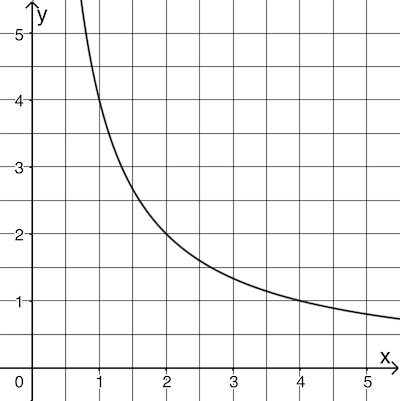Gegeben ist die in \(\mathbb R^+\) definierte Funktion \(g \colon x \mapsto \dfrac{4}{x}\). Abbildung 1 zeigt den Graphen von \(g\).
 Abb. 1
Abb. 1
Berechnen Sie den Wert des Integrals \(\displaystyle \int_1^e g(x)dx\).
(2 BE)
Lösung zu Teilaufgabe 2a
\[g(x) = \frac{4}{x}; \; D_g = \mathbb R^+\]
Berechnung bestimmter Integrale
\[\int_{a}^{b} f(x)\,dx = [F(x)]_{a}^{b} = F(b) - F(a)\]
Dabei ist \(F\) eine beliebige Stammfunktion zu \(f\).
(vgl. Merkhilfe)
Eigenschaften des bestimmten Integrals - Integrationsregeln
Identische Integrationsgrenzen:
\[\int_{a}^{a} f(x)\,dx = 0\]
Faktorregel:
\(\displaystyle \int_{a}^{b} c \cdot f(x)\,dx = c \cdot \int_{a}^{b} f(x)\,dx\) mit \(c \in \mathbb R\)
Summenregel:
\[\int_{a}^{b} \left[f(x) \pm g(x) \right] dx = \int_{a}^{b}f(x)\,dx \pm \int_{a}^{b}g(x)\,dx\]
Vertauschungsregel:
\[\int_{a}^{b}f(x)\,dx = -\int_{b}^{a}f(x)\,dx\]
Zerlegung in Teilintervalle:
\(\displaystyle \int_{a}^{b}f(x)\,dx = \int_{a}^{c}f(x)\,dx + \int_{c}^{b}f(x)\,dx\) mit \(a \leq c \leq b\)
\[\begin{align*} \int_1^e g(x) dx &= \int_1^{e} \frac{4}{x} dx \\[0.8em] &= \int_1^{e} \textcolor{#e9b509}{4} \cdot \frac{1}{x} dx &&| \; \int_{a}^{b} \textcolor{#e9b509}{c} \cdot f(x)\,dx = \textcolor{#e9b509}{c} \cdot \int_{a}^{b} f(x)\,dx; \; \textcolor{#e9b509}{c} \in \mathbb R \; \text{(optional)} \\[0.8em] &= \textcolor{#e9b509}{4} \cdot \int_1^{e} \textcolor{#e9b509}{\frac{1}{x}} dx &&| \; \int \textcolor{#e9b509}{\frac{1}{x}} dx = \textcolor{#e9b509}{\ln{x} + C} \\[0.8em] &= 4 \cdot \left[\textcolor{#e9b509}{\ln{x}}\right]_{\textcolor{#0087c1}{1}}^{\textcolor{#0087c1}{e}} \\[0.8em] &= 4 \cdot (\ln{\textcolor{#0087c1}{e}} - \ln{\textcolor{#0087c1}{1}}) &&| \; \ln{e} = 1; \; \ln{1} = 0\; (\text{allg.:}\; \log_{a}{a} = 1; \; \log_{a}{1} = 0) \\[0.8em] &= 4\end{align*}\]


